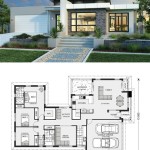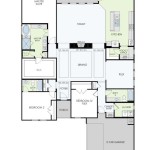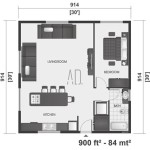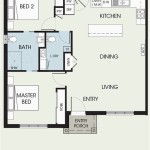Two-Story House Plans With Basement: Maximizing Space and Functionality
Two-story house plans with a basement offer a compelling combination of expanded living space, enhanced functionality, and potential for increased property value. This architectural design allows homeowners to leverage vertical space, maximizing the footprint of the lot while incorporating a versatile lower level that can serve a multitude of purposes. Understanding the benefits, design considerations, and potential challenges associated with this type of home is crucial for making an informed decision when planning a new build or renovation.
The appeal of two-story homes with basements stems from their ability to address a variety of needs. For growing families, the added square footage provides ample room for bedrooms, living areas, and recreational spaces. For those seeking to downsize without sacrificing essential amenities, the basement can function as a guest suite, home office, or hobby room. Furthermore, the presence of a basement offers practical benefits such as additional storage, protection from severe weather, and potential for future expansion.
Benefits of Choosing a Two-Story House Plan with a Basement
There are several advantages to opting for a two-story house plan with a basement. These benefits range from increased living space to enhanced property value, making it a desirable choice for many homeowners.
Firstly, the most obvious benefit is the expanded living space. A basement effectively doubles the usable square footage of the home without significantly increasing the footprint on the lot. This allows for more bedrooms, bathrooms, living areas, and dedicated spaces such as home theaters, gyms, or workshops. The flexibility of the basement space also allows homeowners to customize it to their specific needs and preferences, creating a truly personalized living environment. For instance, a partially finished basement can provide a dedicated play area for children while leaving space unfinished for storage and utilities.
Secondly, a basement provides enhanced functionality and adaptability. Unlike above-ground spaces, the basement can be easily adapted to serve a variety of purposes. It can function as a self-contained apartment for rental income, a guest suite for visiting family and friends, or a dedicated home office for remote work. The basement also offers a discreet location for utility systems such as HVAC units, water heaters, and electrical panels, freeing up valuable space on the upper floors. Furthermore, the basement's inherent thermal mass can contribute to energy efficiency by helping to regulate indoor temperatures and reduce heating and cooling costs.
Thirdly, a basement provides significant protection from severe weather events. In regions prone to tornadoes, hurricanes, or severe storms, a basement can serve as a safe haven, providing a secure location to shelter during emergencies. The concrete walls and underground location offer superior protection compared to above-ground structures. Additionally, the basement can be equipped with emergency supplies such as food, water, and first-aid kits, ensuring preparedness in the event of a natural disaster.
Finally, a finished basement typically increases the overall property value. Potential buyers often view a finished basement as an added bonus, increasing the home's appeal and marketability. Even an unfinished basement can add value, as it provides the option for future expansion and customization. The added living space and functionality contribute to a higher appraisal value, making it a worthwhile investment in the long run.
Key Design Considerations for Two-Story House Plans with Basements
Designing a two-story house plan with a basement requires careful consideration of several factors, including site conditions, structural integrity, and code compliance. Addressing these considerations early in the design process is crucial for ensuring a successful and functional outcome.
Site conditions play a critical role in determining the feasibility and cost of building a basement. The soil type, drainage patterns, and water table level must be carefully evaluated to ensure the basement remains dry and structurally sound. In areas with high water tables, waterproofing measures such as exterior drainage systems, sump pumps, and waterproof membranes are essential. Additionally, the slope of the lot can impact the design of the basement, with walk-out basements being a popular option for sloped lots, allowing for natural light and access to the outdoors.
Structural integrity is another paramount consideration when designing a basement. The foundation walls must be strong enough to withstand the lateral pressure of the surrounding soil and the weight of the house above. This typically involves using reinforced concrete or masonry blocks. The design must also account for potential seismic activity, ensuring the basement can withstand earthquakes. A qualified structural engineer should be consulted to ensure the basement is properly designed and constructed to meet all applicable building codes.
Code compliance is essential for ensuring the safety and legality of the basement. Building codes typically regulate aspects such as ceiling height, egress windows, fire safety, and ventilation. Egress windows are required in all bedrooms and living areas in the basement to provide a means of escape in case of a fire. Proper ventilation is also crucial for preventing moisture buildup and maintaining air quality. It is important to consult with local building officials to ensure the design meets all applicable codes and regulations.
The design of the basement should also integrate seamlessly with the overall architectural style of the house. The exterior of the basement should be aesthetically pleasing and blend in with the rest of the home. This can be achieved through the use of appropriate siding materials, landscaping, and lighting. The interior of the basement should also be designed to complement the upper floors, creating a cohesive and inviting living space.
Potential Challenges and Solutions
While two-story house plans with basements offer numerous benefits, they also present potential challenges that need to be addressed during the planning and construction phases. Understanding these challenges and implementing appropriate solutions can help ensure a successful project.
Moisture control is one of the most common challenges associated with basements. Groundwater, rainwater runoff, and condensation can all contribute to moisture problems, leading to mold growth, musty odors, and structural damage. Effective waterproofing measures are essential for preventing moisture intrusion. This includes installing exterior drainage systems, applying waterproof coatings to the foundation walls, and using a vapor barrier under the basement floor. Proper ventilation is also crucial for reducing humidity levels and preventing condensation. Dehumidifiers can be used to further control moisture levels in the basement.
Radon mitigation is another important consideration, particularly in areas with high radon levels. Radon is a naturally occurring radioactive gas that can seep into basements through cracks in the foundation. Prolonged exposure to radon can increase the risk of lung cancer. Radon mitigation systems typically involve installing a vent pipe and fan to draw radon gas from beneath the foundation and vent it to the outside. Radon testing should be conducted to determine the radon levels in the basement, and mitigation measures should be implemented if necessary.
Accessibility can be a challenge for some basements, particularly those with limited headroom or narrow staircases. Ensuring adequate headroom and providing a comfortable staircase are important for making the basement accessible and usable. Building codes typically specify minimum headroom requirements and staircase dimensions. In some cases, it may be necessary to modify the existing staircase or add a new staircase to improve accessibility. Ramps or elevators can also be considered for individuals with mobility issues.
Finally, cost considerations are crucial when planning a basement. Building a basement can add significantly to the overall cost of the house. The cost will vary depending on factors such as the size of the basement, the complexity of the design, and the site conditions. It is important to obtain accurate cost estimates from qualified contractors and to factor in potential unforeseen expenses. Value engineering techniques can be used to reduce costs without compromising quality or functionality. This may involve using alternative building materials, simplifying the design, or phasing the construction over time.
In conclusion, two-story house plans with basements offer a compelling combination of expanded living space, enhanced functionality, and potential for increased property value. By carefully considering the benefits, design considerations, and potential challenges, homeowners can create a versatile and valuable addition to their home.

Stylish And Smart 2 Story House Plans With Basements Houseplans Blog Com

Stylish And Smart 2 Story House Plans With Basements Houseplans Blog Com

Stylish And Smart 2 Story House Plans With Basements Houseplans Blog Com

Stylish And Smart 2 Story House Plans With Basements Houseplans Blog Com

4000 Sf Contemporary 2 Story 4 Bedroom House Plans Bath 3 Car Garage Two Open Floor Basement

Four Bedroom Home Design With Office Plan 4968

2 Story House Floor Plans 6 Bedroom Craftsman Home Design With Basement

Stylish And Smart 2 Story House Plans With Basements Houseplans Blog Com

Two Story House Design With 2 Car Garage And Basement Decors

2 Story House Plans Designs Small The Designers








